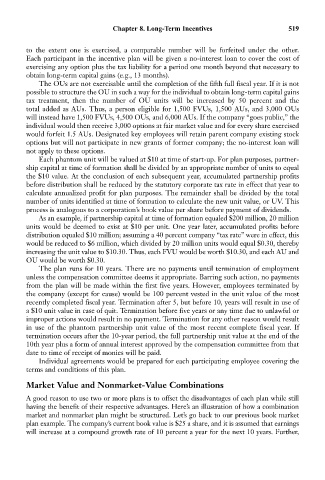Page 533 - Bruce Ellig - The Complete Guide to Executive Compensation (2007)
P. 533
Chapter 8. Long-Term Incentives 519
to the extent one is exercised, a comparable number will be forfeited under the other.
Each participant in the incentive plan will be given a no-interest loan to cover the cost of
exercising any option plus the tax liability for a period one month beyond that necessary to
obtain long-term capital gains (e.g., 13 months).
The OUs are not exercisable until the completion of the fifth full fiscal year. If it is not
possible to structure the OU in such a way for the individual to obtain long-term capital gains
tax treatment, then the number of OU units will be increased by 50 percent and the
total added as AUs. Thus, a person eligible for 1,500 FVUs, 1,500 AUs, and 3,000 OUs
will instead have 1,500 FVUs, 4,500 OUs, and 6,000 AUs. If the company “goes public,” the
individual would then receive 3,000 options at fair market value and for every share exercised
would forfeit 1.5 AUs. Designated key employees will retain parent company existing stock
options but will not participate in new grants of former company; the no-interest loan will
not apply to these options.
Each phantom unit will be valued at $10 at time of start-up. For plan purposes, partner-
ship capital at time of formation shall be divided by an appropriate number of units to equal
the $10 value. At the conclusion of each subsequent year, accumulated partnership profits
before distribution shall be reduced by the statutory corporate tax rate in effect that year to
calculate annualized profit for plan purposes. The remainder shall be divided by the total
number of units identified at time of formation to calculate the new unit value, or UV. This
process is analogous to a corporation’s book value per share before payment of dividends.
As an example, if partnership capital at time of formation equaled $200 million, 20 million
units would be deemed to exist at $10 per unit. One year later, accumulated profits before
distribution equaled $10 million; assuming a 40 percent company “tax rate” were in effect, this
would be reduced to $6 million, which divided by 20 million units would equal $0.30, thereby
increasing the unit value to $10.30. Thus, each FVU would be worth $10.30, and each AU and
OU would be worth $0.30.
The plan runs for 10 years. There are no payments until termination of employment
unless the compensation committee deems it appropriate. Barring such action, no payments
from the plan will be made within the first five years. However, employees terminated by
the company (except for cause) would be 100 percent vested in the unit value of the most
recently completed fiscal year. Termination after 5, but before 10, years will result in use of
a $10 unit value in case of quit. Termination before five years or any time due to unlawful or
improper actions would result in no payment. Termination for any other reason would result
in use of the phantom partnership unit value of the most recent complete fiscal year. If
termination occurs after the 10-year period, the full partnership unit value at the end of the
10th year plus a form of annual interest approved by the compensation committee from that
date to time of receipt of monies will be paid.
Individual agreements would be prepared for each participating employee covering the
terms and conditions of this plan.
Market Value and Nonmarket-Value Combinations
A good reason to use two or more plans is to offset the disadvantages of each plan while still
having the benefit of their respective advantages. Here’s an illustration of how a combination
market and nonmarket plan might be structured. Let’s go back to our previous book market
plan example. The company’s current book value is $25 a share, and it is assumed that earnings
will increase at a compound growth rate of 10 percent a year for the next 10 years. Further,

